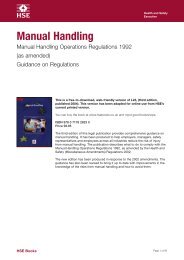Making Companies Safe - what works? (CCA ... - Unite the Union
Making Companies Safe - what works? (CCA ... - Unite the Union
Making Companies Safe - what works? (CCA ... - Unite the Union
Create successful ePaper yourself
Turn your PDF publications into a flip-book with our unique Google optimized e-Paper software.
to cost “a little” or “nothing significant”, and conclude that: “Given that <strong>the</strong> majority of<br />
organisations… believe that <strong>the</strong>y measure <strong>the</strong> costs of ill-health well or very well, this appears<br />
to represent a reportedly ‘well-informed’ opinion”. 69 In o<strong>the</strong>r words (and as Wright et al.<br />
acknowledge elsewhere in <strong>the</strong>ir report) it may be <strong>the</strong> case that ill-health does not in fact cost<br />
employers a significant amount in most circumstances. Moreover, <strong>the</strong> discussion in <strong>the</strong><br />
previous section suggests that <strong>the</strong>re are potential dangers in encouraging employers to base<br />
action around OHS on economic calculations, since <strong>the</strong>se can lead to skewed action, and even<br />
to action that does not promote <strong>the</strong> health and safety of workers.<br />
In relation to <strong>the</strong> argument that <strong>the</strong>re are a number of separate elements to <strong>the</strong> business case<br />
beyond <strong>the</strong> economic argument, <strong>the</strong> evaluation of <strong>the</strong> GHGB campaign found that only 8%<br />
of employers who were aware of <strong>the</strong> campaign (that is, who had been presented with <strong>the</strong><br />
‘business’ arguments for improved occupational health management) reported that <strong>the</strong>y were<br />
prompted to make improvements due to business impacts, and this included all elements of<br />
<strong>the</strong> business case and not just <strong>the</strong> economic case. Moreover, only 10 per cent thought that<br />
evidence of business impacts would prompt <strong>the</strong>m to do more. 70 Therefore it appears that<br />
employers are not greatly motivated by o<strong>the</strong>r business factors, such as PR, customer pressure<br />
or supply chain pressures (see above).<br />
Fur<strong>the</strong>rmore, it should be stressed that reputational risk provides only a partial lever. Not all<br />
firms are reputationally sensitive and it is clear that even amongst those that are, reputational<br />
risk does not always provide a sufficient motivation to maintain or achieve good standards of<br />
OHS. Nei<strong>the</strong>r does it provide motivation in relation to those aspects of OHS that companies<br />
feel <strong>the</strong>y will not be judged on publicly. This means that at best, reputational risk is will result<br />
in uneven attention to OHS, with regulation needed to apply pressure to manage those risks<br />
that do not give rise to reputational concerns.<br />
It should be clear from <strong>the</strong> preceding discussion that:<br />
• Poor health and safety performance does not always damage an organisation’s<br />
reputation in a way that will have a negative impact on its commercial position.<br />
• The range of contexts in which organisations might be motivated by concern for <strong>the</strong>ir<br />
reputations or by o<strong>the</strong>r business considerations to improve OHS appears to be quite<br />
limited.<br />
• Even if business levers and reputational risk acted as significant motivators of voluntary<br />
compliance and improvement in most situations, <strong>the</strong> activity of regulators would still be<br />
key, for <strong>the</strong> following reasons:<br />
o inspection and enforcement are key to detection and <strong>the</strong> allocation of blame, and<br />
o inspection and enforcement are vital to correcting to skewed effects of business<br />
and reputational pressures.<br />
Fear of loss of corporate credibility, <strong>the</strong>refore, depends on a system of frequent and<br />
widespread inspection and investigation to create a high probability of detection. It also<br />
depends on a perception that regulators will not tolerate, and will take vigorous enforcement<br />
action in <strong>the</strong> face of persistent failures to adequately control risks. The evidence suggests that<br />
current levels of HSE inspection, investigation and enforcement are too low to create a high<br />
level of concern for reputational damage.<br />
<strong>Making</strong> <strong>the</strong> Moral and Social Case<br />
78<br />
The current Chair of <strong>the</strong> HSC has stated that, “if we want long-term gains we need hearts<br />
and minds, not grudging acceptance”. 71 It must be said that <strong>the</strong> HSC/E has so far put much<br />
more effort into winning ‘minds’ (through promotion of <strong>the</strong> business case) than it has into<br />
winning ‘hearts’ (through presentation of <strong>the</strong> moral and social case). A shift in emphasis<br />
towards presentation of <strong>the</strong> human costs of work-related injuries, ill-health and death would<br />
be welcome. In comparison to <strong>the</strong> focus on reputational and economic risks, arguments<br />
based on <strong>the</strong> moral case for improved OHS performance are less likely to prompt a skewed<br />
response from employers.
















